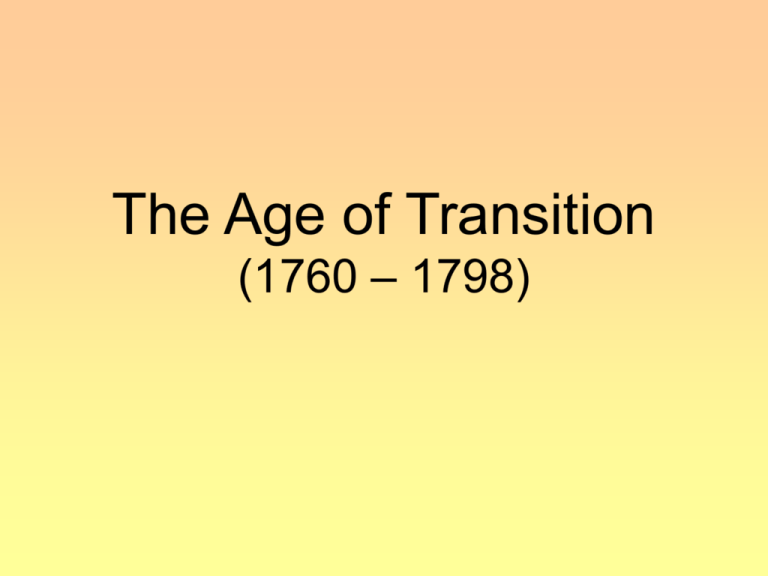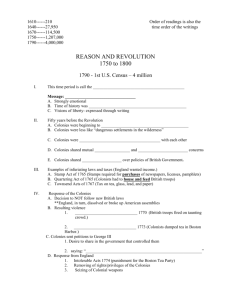The Age of Transition (1760 – 1798)
advertisement

The Age of Transition (1760 – 1798) A new sensibility: ROMANTICISM • Reaction against the faith in reason of the Augustan Age Classical features Early romantic features - - originality, creativity - focus on the individual - feelings, emotions - free imagination - interest in the Middle Ages - exotic places - nature as a real, living being Imitation ‘social’ writer Reason Established rules Classical Greece and Rome Routine-life, domestic environment Nature as an abstract, philosophycal concept INFLUENCES • Sturm und Drang (70s): strongly nationalistic literary movement • Mme De Staël : De l’Allemagne • J. J. Rousseau: the theory of the noble savage importance of childhood and nature Features • • • • • • • • • • Nature Feelings and emotions Strong individualism Melancholy The sublime Discovery of the popular traditions of the Middle Ages Taste for the desolate; love of ruines… Imagination Cult of the exotic Nationalism/patriotism C. D. Friedrich, The Monk by the Sea (1808-10) C.D.Friedrich, Wanderer above the Sea Fog (1818) Historical background • Under the reign of George III the main events were: 1. The loss of the American colonies 2. The French Revolution 3. The Industrial and Agricultural Revolutions The loss of the American colonies • The Americans: not represented in English Parliament • 1773: Boston Tea Party: ‘no taxation without representation’ • 1775: war broke out • 1776: Declaration of Independence (Thomas Jefferson) • G. Washington: 1st President • 1783: Treaty of Versailles • American society: a melting pot • Birth of the ‘American Dream’ The Boston Tea Party • A political protest whose demontrators, disguised as American Indians, destroyed an entire shipment of tea sent by the East India Company. The American colonies refused to pay taxes to the mother country (Tea Act, 1773) unless they had representatives in the British Parliament. The thirteen American colonies declared their independence from the British Empire. They formed a new nation: the United States of America. The French Revolution and Napoleon • • • • • Concepts of freedom, brotherhood, equality Initial enthusiasm Patriotic sentiments, nationalism ‘Terror’ period Napoleon: at first England remained neutral but then, worried about a possible French egemony in Europe, it took part in the war against France. • English navy very strong: Napoleon defeated in 1805 by admiral Nelson (Battle of Trafalgar) Trafalgar Square in London Admiral Horatio Nelson The Industrial and Agricultural Revolutions • • • • • • • • • • • • • England became a manifacturing country Increase in population Demand for goods/clothes Improvement of technology / inventions Raw materials in the North Transport: roads, railway, canals New industrial towns (mushroom towns) Urbanisations lack of hygiene, overcrowded slums Working conditions: alienation, heavy drinking, diseases. Use of fertilisers, crop rotation, machines Inhuman working conditions, machinery broken by workers then punished by the Government 1799: COMBINATION ACTS (Trade Unions of workers = illegal) 1819: Peterloo Massacre The spinning frame invented in 1764 by James Hargreaves http://www.history.com/topics/industrial-revolution Pre-Romantic Poetry • GRAVEYARD POERTY: melancholy, a sombre mood, interest in graves, death, ruins, desert places. - Thomas Gray: Elegy written in a country churchyard • OSSIANIC POETRY: new sources of inspitation found in Nordic and Celtic culture. - James Macpherson: Fragments of Ancient Poetry Fragments of Celtic poetry attributed to OSSIAN, a legendary warrior and bard of the 3rd century.




